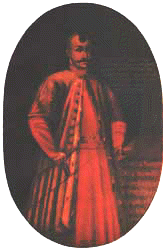Like the family of Ostrozkiís Koretskiís led their origin from the son of the great Lithuanian prince Gedimin-Narimunt. In XIV century the Koretskiís arrived to Volyn, where they owned small town Korets.
Soon through that town the brisk trade way went from Moldova to Moscow (it passed also throughBratslav and Vinnitsa), which brought a stable income to princes Koretskiís.
Not without reason in 1566 the owners of Korets flatly refused to establish in the city a state customs house. The destiny of the prince Bogush Fedorovich Koretski, the governor of Bratslava and Vinnitsa is closely connected with Vinnitsa in 1548-1576. He has come into the history of this city as the last Orthodoxy Head, who has done much for the prosperity and strengthening of Vinnitsa. In archives there are documents, which testify to economic activity of the prince Bogush, construction of churches, differentiation of urban grounds and so on. It is necessary to note, that the inheritance, left to Koretskiy by his predecessor on the post of Head Fedor Sangushko, was not very easy.
The audit, carried out in 1545, of the Vinnitsa castle showed its actual inability to protect the territory and the population from hostile attacks. All this required the immediate decision, and prince Koretskiy managed in the shortest terms to repair the walls of a fortress, to update an arsenal, to collect new divisions of the military men- draby.
Just Bogush Fedorovich had the idea about transferring the castle on Kemp island, in connection with expansion of urban territory. In some years this idea was realized by another Head - Valentiy Kalinovski.
Bogush Koretskiy planned to give the post of the Head of Vinnitsa to his son Ukhim (on this account he made the appropriate order), however after the death of prince Bogush the situation radically changed.
Vinnitsa government was handed to Uriy Strus, and the Koretskiís were to be satisfied by several small castles (Dasheve, Lintsi etc) on Bratslavshchina
At the beginning of XVII century the considerable popularity was achieved by Samuil Koretskiy, who bravely struggled against Turkish army.In "Ostrozkiy chronicler"' in 1616 there is a story about capturing of the prince Koretskiy by Turks. For the second time he became a Turkish prisoner near Cecora in 1620 and soon was killed.
